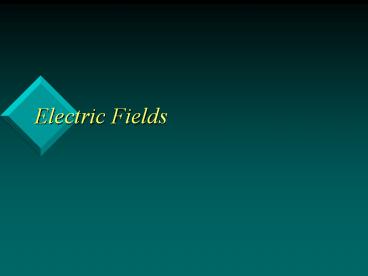Electric Fields - PowerPoint PPT Presentation
Title:
Electric Fields
Description:
Electric Fields What You Will Learn An electric field is like a . An electric field is a . An electric field provides the that a will move ... – PowerPoint PPT presentation
Number of Views:259
Avg rating:3.0/5.0
Title: Electric Fields
1
Electric Fields
2
What You Will Learn
- An electric field is like a .
- An electric field is a .
- An electric field provides the that a
will move if placed in the field. - An electric field is composed of a series of
imaginary .
3
What you already know
- Coulombs Law
F
Note is much smaller than !
4
Electric Field
- The electric field is the that a
experiences divided by itself. - Note The electric field is a and
therefore has magnitude and direction.
F
5
What is the
- It is enough that it does not affect the field
due to other charged objects. - It will move towards or away from other charged
objects depending on whether it is charged
similarly or dissimilarly from other objects.
6
The Test Charge (Cont.)
_
_
Test Charge moves from a positively charged
object
Test Charge moves a negatively charged object
Negatively Charged Object
Positively Charged Object
7
Example
A positive charge of 4.0 x 10-5 C experiences a
force of 0.36 N when located at a certain point.
What is the electric field intensity at that
point?
Note The says nothing about the
magnitude of charge , which is the of the
that produces the that charge
experiences.
8
Electric Field Lines
- Electric field lines, or of , provide a
of the at any point in space from a charge. - Electric field lines show the that a
would take if placed in the
field.
_
_
9
Electric Field Lines
- Electric field lines at and
are always directed away from them towards . - Electric field lines do or
except at the of or charges. - Electric field lines are ( ) to
the where they or . - Electric field lines .
- The strength of the field is proportional to the
magnitude of the charge and is directly related
to the of field lines - the there are and the
together they are, the the field.
10
Electric Field Lines Due to a Point Charge
Direction of field is .
Density of lines is .
Lines intersect .
11
Electric Dipole
Note An electric dipole consists of
in and in .
Note Force on a ( ) is the
field lines, and is the of the forces
due to of the dipole acting on it.
12
Examples from the Web
http//www.cco.caltech.edu/phys1/java/phys1/EFiel
d/EField.html http//phet.colorado.edu/sims/charg
es-and-fields/charges-and-fields_en.html
13
Electric Fields and Conductors
- At equilibrium, excess charges will reside on the
of a conductor. - The electric field is at any point within a
conducting material at . - Charge within a conductor is from external
electric fields because they or on the
where excess charges reside.
E
E-Field inside conductor
14
Parallel Plate Capacitor
- The parallel plate capacitor is an device
used in all kinds of electronics. - Field lines in a parallel plate capacitor are
and to one another, indicating a
electric field.
- - - - - - - -
15
Electrostatic Force and Distance
- For point charges
- The strength of the field as the distance .
16
Electrostatic Force and Distance
- For parallel plates
- The strength of the field is from one
plate to the other. - Since , the will be .
17
Force and Electric Field Strength vs. Distance
- Point Charge Parallel Plate
18
Example (Millikan Oil Drop Exp.)
An oil drop is negatively charged and weighs 8.5
x 10-14 N. The drop is suspended in an electric
field intensity of 5.3 x 101 N/C. What is the
charge on the drop? How many electrons is
that?
19
Key Ideas
- Electric fields exists around any conductor or
insulator that contains a charge. - The electric field intensity is a measure of the
force on a test charge placed in the field. - The strength of the field is proportional to the
density of field lines. - Field lines are perpendicular to all charged
surfaces. - The electric field is always directed away from
positive charges and towards negative charges.































